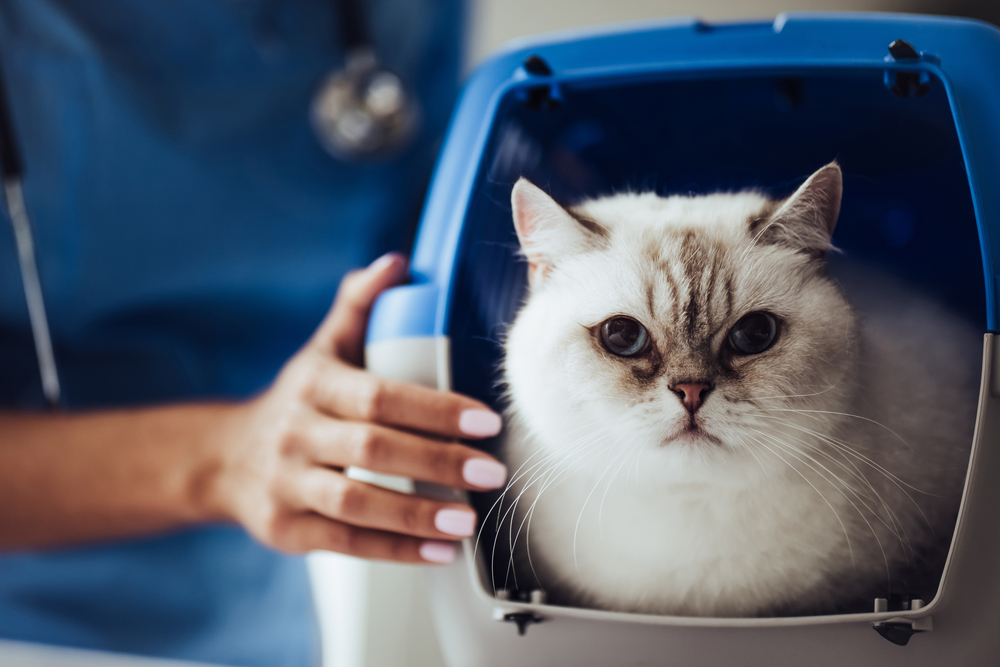America’s cats are facing a healthcare crisis. The findings of a feline health study conducted by Bayer Health Care in 2014 found that 52 percent of America’s 74 million cats are not receiving regular veterinary care. The actual number is probably much higher, since this study captured data only from cat owners who seek some veterinary care, not those who never take their cat to the veterinarian.
These disheartening statistics have two main reasons. One is the perception among many cat owners that cats don’t need veterinary care – a misconception perpetuated by the feline ability to hide signs of illness. Veterinarians often don’t see cats until an illness is advanced. Often, that’s because getting a cat to the veterinary clinic can be such a stressful experience for both cat and human that even conscientious cat parents throw in the towel at the thought.
Veterinary clinics have made great strides over the last few years to create a less stressful experience for cats once they arrive at the clinic. However, making vet visits less stressful for cats begins with a number of things cat parents can do at home, long before the actual trip to the clinic.
Get Your Cat Used to the Carrier
The cat carrier should be part of your cat’s everyday life. Not only will it make the trip to the vet easier, it can also save your cat’s life in case of an emergency. Creating a positive experience with the carrier is key to a fear-free vet visit.
From picking the right carrier to making it an alluring part of your cat’s everyday environment, training a cat to accept the carrier is not difficult. It just takes persistence on the human’s part and lots of rewards for the cat.
Don’t stash the carrier in the basement or a closet. Keep it out in an area where your cat spends a lot of time. Make it interesting for your cat by keeping a cat bed or soft blanket inside. If your cat responds to catnip, sprinkle it with catnip. Leave favorite toys or treats inside. You may even want to feed your cat inside the carrier.
Once your cat willingly enters the carrier and is comfortable in it, practice closing the door. Close the door for only a few moments and reward your cat with a treat if he remains calm. Gradually increase the time you leave him in the carrier. Practice picking up the carrier, holding it carefully in both arms. Work up to taking short rides with your cat in the car.
Calming Remedies
Spraying the carrier with feline pheromone sprays or calming remedies such as Rescue Remedy or Stress Stopper can help keep your cat calm. These remedies can also be great tools to use while you get your cat used to the carrier.
Medical Aids
For cats who become extremely stressed during a vet visit, a medication called gabapentin, commonly used to treat chronic pain and epilepsy in humans, can make a significant difference in how some cats experience a veterinary visit. The medication has few side effects, and any that do occur are usually transient. The general recommendation is to administer a capsule 90 minutes before putting the cat in the carrier.
Andrea Tasi, VMD, owner of Just Cats Naturally, a feline house call practice, has used gabapentin successfully with her patients. “It is remarkable to me that cats who previously hid from me or were otherwise impossible to handle will now come to me and be relaxed enough so I can perform a thorough physical exam,” Dr. Tasi says. Even though Dr. Tasi’s practice focuses on homeopathic and holistic remedies, she believes in an integrative approach to medicine: “If I can minimize stress for my patients with a safe medication with few side effects, that’s good for the cat and the cat’s guardian.”
Limit Food and Treats Prior to a Vet Visit
Veterinarians and staff like to use treats to create a positive association with a vet visit for your cat. By limiting food or treats before the visit, your cat will be more receptive to the veterinary offerings. She will also be less likely to get car sick.
In the Car
Most cat owners place the carrier on the passenger seat and use the seatbelt to secure it. Unless your cat carrier has been crash-tested and certified, Center for Pet Safety founder Lindsey Wolko has this advice: “Don’t use the seatbelt to strap in the carrier. Place plastic carriers and soft-sided carriers on the floor of the vehicle behind the front driver or passenger seats.”
Cover the carrier with a towel to reduce your cat’s exposure to potentially frightening sights and sounds. Even though your instinct may be to talk to your cat in the car, unless you are truly relaxed, worried emotional talk such as “There, there, it will be okay; I’m not going to let anything bad happen to you” will probably not calm your cat. Instead, play calming music composed especially for cats.
Manage Your Own Energy
Cats are sensitive and pick up on their humans’ stress. For this reason, it’s important to manage your own energy before and during a vet visit. Your stress at the thought of taking your cat to the vet can make a visit more challenging than it needs to be.
This article was reviewed/edited by board-certified veterinary behaviorist Dr. Kenneth Martin and/or veterinary technician specialist in behavior Debbie Martin, LVT.








